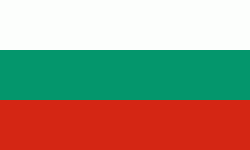Petrevene
Petrevene (Петревене, or ) is a village in North Central Bulgaria. It is situated on the left bank of Panega river (Панега, also: Zlatna Panega, Златна Панега, 'Golden Panega', old: Paneg, Altǎn Paneg). It is in the Municipality of Lukovit, part of the District of Lovech, and is 6 km away from the municipality center of Lukovit. The main road E-83 and the railroad Cherven Bryag—Zlatna Panega pass through it.
Historical records of the settlement date back from the early 15th century, during the Ottoman Empire, although evidence from the surrounding areas indicate the area was likely settled much earlier. Historically, it has been an important part of the marble trade, and is notable for its long history of shifting Pomak Muslim and Christian village populations and tensions.
It known for its local festival, Watermelon Day – a longstanding and popular local tradition dating back to 1936. The local economy is based around small farming, particularly cattle, and services to traffic from the local high road.
The etymology of Petrevene's name likely stems from the ancient Greek word for stone, petros (πέτρoς), as the Nabataean city of Petra, now in Jordan. Indeed, there are numerous sandstone quarries nearby, used since ancient times. High quality stones (though not real marble) from them have been extracted and exported even to Romania. Petrevene's medieval name, Mramor or Mramornitza, i.e. 'marble', seems to support this hypothesis. In fact, under the name of 'Miramor, Mromor', i.e. 'Mramor', soon after the Ottoman invasion Petrevene was listed in Tahrir Defter, the first Ottoman tax registry of 1430. Probably, even before that, during the Second Bulgarian State, its name was still Mramor or Mramornitza. It is quite possible also that Petrevene is named after some individual called Petǎr (indeed, in its vicinity there are ruins known as Petrova gradezh, i.e. 'Peter's construction' )—a village elder, or an Eastern Orthodox monk (of the nearby Middle Age monastery of St. Peter and St. Paul, the ruins of which can be found near the bridge of the Belenska River south of the village). The alternative name under which Petrevene is listed in Tahrir Defter, "Petreve sele", i.e. "Petrevo selo", seems to support this hypothesis. It is quite possible that the name came from both of the above hypotheses.
Historical records of the settlement date back from the early 15th century, during the Ottoman Empire, although evidence from the surrounding areas indicate the area was likely settled much earlier. Historically, it has been an important part of the marble trade, and is notable for its long history of shifting Pomak Muslim and Christian village populations and tensions.
It known for its local festival, Watermelon Day – a longstanding and popular local tradition dating back to 1936. The local economy is based around small farming, particularly cattle, and services to traffic from the local high road.
The etymology of Petrevene's name likely stems from the ancient Greek word for stone, petros (πέτρoς), as the Nabataean city of Petra, now in Jordan. Indeed, there are numerous sandstone quarries nearby, used since ancient times. High quality stones (though not real marble) from them have been extracted and exported even to Romania. Petrevene's medieval name, Mramor or Mramornitza, i.e. 'marble', seems to support this hypothesis. In fact, under the name of 'Miramor, Mromor', i.e. 'Mramor', soon after the Ottoman invasion Petrevene was listed in Tahrir Defter, the first Ottoman tax registry of 1430. Probably, even before that, during the Second Bulgarian State, its name was still Mramor or Mramornitza. It is quite possible also that Petrevene is named after some individual called Petǎr (indeed, in its vicinity there are ruins known as Petrova gradezh, i.e. 'Peter's construction' )—a village elder, or an Eastern Orthodox monk (of the nearby Middle Age monastery of St. Peter and St. Paul, the ruins of which can be found near the bridge of the Belenska River south of the village). The alternative name under which Petrevene is listed in Tahrir Defter, "Petreve sele", i.e. "Petrevo selo", seems to support this hypothesis. It is quite possible that the name came from both of the above hypotheses.
Map - Petrevene
Map
Country - Bulgaria
 |
 |
| Flag of Bulgaria | |
One of the earliest societies in the lands of modern-day Bulgaria was the Neolithic Karanovo culture, which dates back to 6,500 BC. In the 6th to 3rd century BC the region was a battleground for ancient Thracians, Persians, Celts and Macedonians; stability came when the Roman Empire conquered the region in AD 45. After the Roman state splintered, tribal invasions in the region resumed. Around the 6th century, these territories were settled by the early Slavs. The Bulgars, led by Asparuh, attacked from the lands of Old Great Bulgaria and permanently invaded the Balkans in the late 7th century. They established the First Bulgarian Empire, victoriously recognised by treaty in 681 AD by the Eastern Roman Empire. It dominated most of the Balkans and significantly influenced Slavic cultures by developing the Cyrillic script. The First Bulgarian Empire lasted until the early 11th century, when Byzantine emperor Basil II conquered and dismantled it. A successful Bulgarian revolt in 1185 established a Second Bulgarian Empire, which reached its apex under Ivan Asen II (1218–1241). After numerous exhausting wars and feudal strife, the empire disintegrated and in 1396 fell under Ottoman rule for nearly five centuries.
Currency / Language
| ISO | Currency | Symbol | Significant figures |
|---|---|---|---|
| BGN | Bulgarian lev | лв | 2 |
| ISO | Language |
|---|---|
| BG | Bulgarian language |
| TR | Turkish language |















